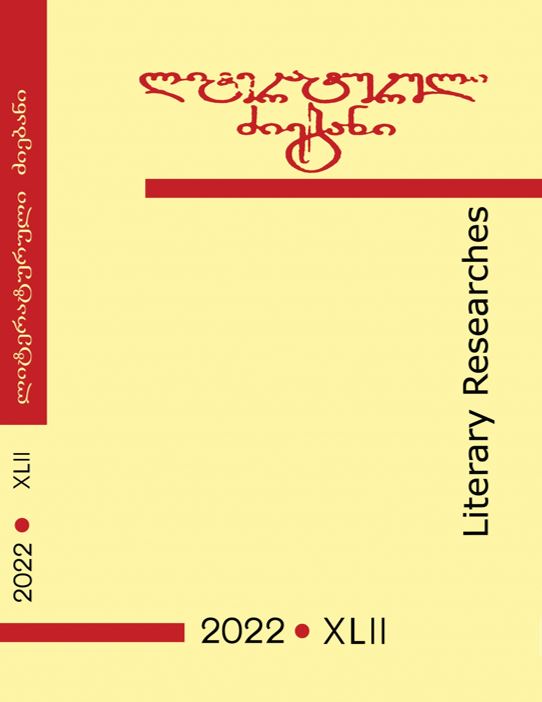Published 2022-04-30
Keywords
- title,
- „martirologies“,
- „lives“,
- information,
- structure
How to Cite
Abstract
The title is one of the important components of a text. In general, it shows the epoch, the genre, the style of the literary text, themes and features of the artistic image, the worldview of the author and the phenomenon of the reader (his taste, spiritual values).
Observation of the titles of original Georgian hagiographic works reveals a number of issues worthy of an attention. As a result of a detailed analysis of the titles of the “martyrdoms” and “lives” of the saints, the following was singled out: the titles of hagiographic works, first of all, determine the genre, “martyrdom” or “life-citizenship”; However, the difference can be seen in the structure and content of the titles of the same genre. The titles of “martyrdoms” are ambiguous; There are both long, informative titles and short, concise titles that name only the main character, and may also mention his nationality or place of origin. In long titles, in most cases, the name of the author and the customer also appears. There are headlines that also contain the names of the tormentors, who, together with their religion and nationality, distinguish the era. It should be noted that in one of them (“The Martyrdom of the Saint Eustathius of Mtskheta”) instead of Georgian “tsameba” (Passion) its Greek counterpart is used – “martyrdom” (“martviloba” in Georgian) . It is also worth noting that only once (“The Martyrdom of Saint Abo Tbileli”) is the division of the works into subchapters and their titles, which determines the reader the content and sequence of the narrative, as well as the author’s purposefulness. “Citizenship and Martyrdom”, “Martyrdom and Patience”,
“Life and Martyrdom” can be found in the titles of works of the “Martyrdom” genre, which, in turn, prepares the reader for a story about the protagonist’s inquisitive path, existence, his worldly courage and work.
The names of “lives”, as it turns out, are heterogeneous; keimenon editions are represented by relatively short and concise titles, in metaphrased editions we find both short and long titles, which provide various types of information (personality, epithets, origin, place of service, church rank, merits, author’s name, etc.). Only in one work (“The Life of St. Nino”) we find chapter headings. In the titles of works depicting the activities of the great church fathers, for the most part, one main character is named; There are times when two people are named; There are examples in which, along with the main characters, their associates are also mentioned. In the works of this genre, for the most part, “life and citizenship” is mentioned, which, along with the genre designation, outlines their life path, the worldly achievements of the one following the divine path, and directs the reader’s attention to these areas. It should be noted that in one of them (“The Life of Saint Gregory of Khandzta”) we find “labor and activity”, which, it seems to us, refers to spiritual and physical labor. It should be noted that the title “Life and Miracles” is mentioned only in one case (“The Life of Saint Shio Mgvimeli”), which emphasizes the perfection and grace of the Holy Father. It should be noted that in the titles of “lives”, mostly, while mentioning the hero, the possessive pronoun “We” is used, regardless of his nationality, Georgians or “foreigner”. In the latter case, as we think, for the Georgians, their merits and activities are the determining factor, therefore they show special attention and warmth to the authors, they considered them the children of their people. On the one hand, the title mentions “Gruzinsky” (“The Life of Hilarion Iberian”), which, in our opinion, highlights the merits of St. father in Georgia and abroad (which the reader will learn about after reading the work). Here, unlike other writings, there is one more innovation, namely the concept-term “new”, which marks the similarity with the feat of the predecessor – St. Father Hilarion the Great. Unlike works of the martyrdom genre, the titles of the Lives do not give the reader (at least in general terms) an idea of the era described in the work.
On the basis of a comparison of Georgian hagiographic works with the titles of the same genre of Byzantine texts, the following was distinguished: – The titles in the original Georgian hagiographic works in some cases follow the names of Byzantine hagiographic works, but there are also differences.

